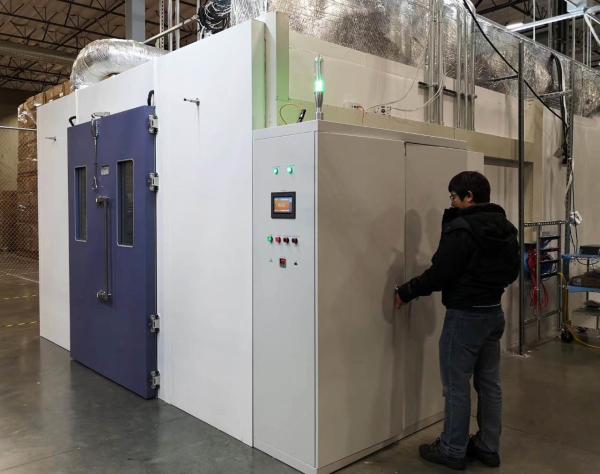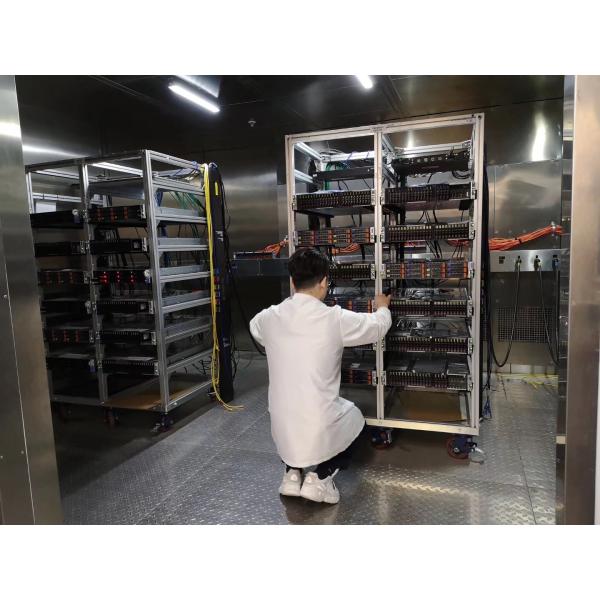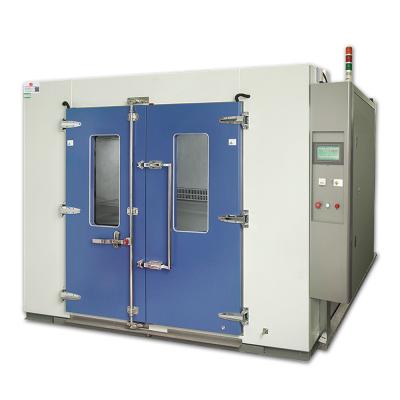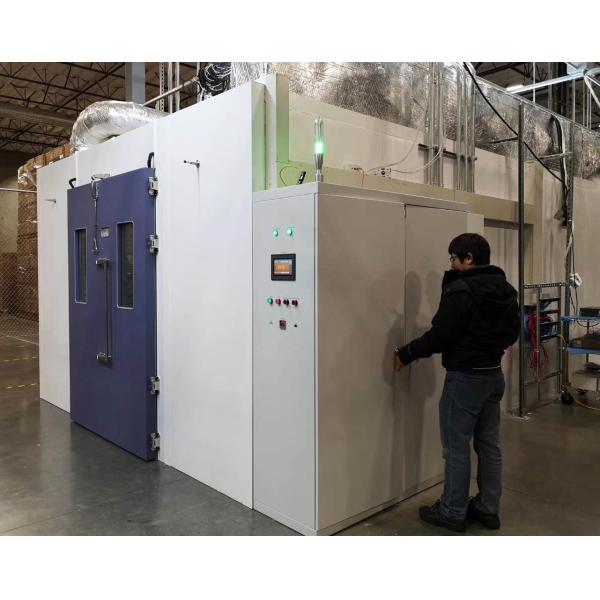In the automotive manufacturing and design process, ensuring the durability and quality of car body and interior components is of utmost importance. The Customized Walk-In Environmental Chamber serves as a crucial tool for subjecting these components to a wide range of environmental conditions, allowing for comprehensive testing and optimization.
This specialized chamber is designed to test car body parts such as panels, frames, and doors, as well as interior components like seats, dashboards, and upholstery. It caters to automotive manufacturers, suppliers, and research institutions. The core objective is to simulate the diverse environmental stresses that these components face during a vehicle's lifespan, including temperature variations, humidity levels, sunlight exposure, and chemical contaminants. By conducting detailed tests, potential weaknesses and areas for improvement can be identified, leading to enhanced product quality and customer satisfaction.
- Spacious and Durable Construction
- The walk-in chamber is built with a heavy-duty framework, typically made of high-strength steel, to support the size and weight of car body and interior components. The exterior is engineered to be highly durable and resistant to corrosion, ensuring a long service life. The interior is designed with a smooth and non-reactive surface to prevent any damage to the tested samples. The door is large and features a reliable sealing mechanism, incorporating a high-quality gasket and a multi-point locking system, maintaining a stable and controlled testing environment. The chamber also includes proper ventilation and exhaust systems to manage any fumes or gases generated during testing.
- Precision Environmental Control Systems
- Temperature Control: Capable of maintaining a wide temperature range, from -40°C to +100°C, with an accuracy of ±0.5°C. It utilizes advanced refrigeration and heating technologies, such as industrial-grade compressors and high-power heating elements. The control system incorporates a feedback loop with multiple temperature sensors strategically placed throughout the chamber, ensuring uniform temperature distribution. The user-friendly control panel allows for precise programming of temperature profiles, including rapid temperature changes and extended soak times, replicating real-world conditions like cold winter nights and hot summer days.
- Humidity Control: The humidity control system can achieve humidity levels from 5% to 95% RH, with an accuracy of ±3% RH. It employs a combination of steam injection and dehumidification methods, along with a carefully designed air circulation pattern. Humidity sensors continuously monitor the internal environment, and the control system adjusts accordingly to create the desired humidity levels. This is essential for testing the effects of moisture on components, such as the growth of mold on upholstery or the corrosion of metal parts in humid conditions.
- UV and Sunlight Simulation: To mimic the effects of sunlight, the chamber is equipped with high-intensity UV lamps. The UV spectrum and intensity can be adjusted to replicate different levels of solar radiation. This allows for the evaluation of how car body paint and interior materials fade, crack, or degrade over time due to UV exposure. Additionally, the chamber can simulate the heat generated by sunlight, further enhancing the realism of the testing environment.
- Chemical and Corrosion Resistance Testing: The chamber can introduce various chemical contaminants, such as salt spray, acid rain, and automotive fluids, to test the resistance of components. It has a dedicated spraying system and a corrosion-resistant interior lining to ensure accurate and reliable testing. This is crucial for assessing the durability of car body parts and their ability to withstand environmental pollutants and corrosive substances.
- Advanced Instrumentation and Data Acquisition
- The chamber is outfitted with a comprehensive suite of sensors and instrumentation. Temperature, humidity, UV intensity, and chemical concentration sensors are connected to a state-of-the-art data acquisition system. The data acquisition system offers a high sampling rate, typically ranging from 100 to 500 samples per second, ensuring that even the most rapid changes in environmental conditions are accurately captured. The collected data can be accessed and analyzed in real-time or retrieved later for in-depth studies. The system is also compatible with automotive industry-specific data analysis software, enabling the generation of detailed reports and graphical representations of the test results.
- Safety and Compliance Features
- The Customized Walk-In Environmental Chamber is designed with multiple safety features. It has an automatic shutdown system in case of any critical malfunction, such as overheating or excessive chemical leakage. The ventilation system is designed to quickly remove any harmful gases or fumes, protecting the operators and the surrounding environment. The chamber also complies with relevant automotive testing standards and regulations, ensuring that the testing procedures are reliable and recognized within the industry.
- Chamber Size and Capacity: The chamber is available in various sizes, with interior dimensions ranging from 3 meters x 3 meters x 2 meters to larger configurations suitable for testing full car bodies or multiple interior components simultaneously. The volume can be adjusted according to the specific needs of the customer, ensuring efficient use of space and proper testing of different-sized samples.
- Temperature Cycling Rate: Can perform temperature cycles at a rate of 2 to 5 cycles per hour, depending on the test requirements. For example, it can rapidly cool from +80°C to -20°C in a matter of minutes and then heat back up, subjecting the components to significant thermal stress, which is essential for evaluating thermal fatigue resistance.
- Humidity Cycling Rate: The humidity can be cycled within 15 to 30 minutes, allowing for the simulation of rapid changes in moisture conditions, such as transitioning from a dry desert environment to a humid rainforest-like atmosphere.
- UV Intensity and Exposure Time: The UV lamps can produce intensities ranging from 0.5 W/m² to 1.5 W/m², and the exposure time can be precisely controlled from a few hours to several weeks, depending on the desired test severity and the specific materials being tested.
- Chemical Concentration and Exposure Duration: The chamber can introduce chemical contaminants at concentrations ranging from 1% to 10% (by volume), and the exposure duration can be set from a few minutes to several days, allowing for a comprehensive assessment of the components' chemical resistance.
- Data Acquisition Rate: The data acquisition system samples sensor data at a rate of 200 to 500 samples per second, providing detailed and accurate information about the environmental conditions and the performance of the tested components during the test.
- Realistic Environmental Simulation for Component Evaluation
- The primary function of this chamber is to provide a highly accurate and realistic simulation of the environmental conditions that car body and interior components will face. By precisely controlling temperature, humidity, UV radiation, and chemical exposure, it allows for the assessment of how these components perform in different scenarios. For example, it can determine if a car body panel's paint will peel or fade under prolonged UV exposure or if an interior fabric will withstand the corrosive effects of spilled coffee and high humidity. This information is invaluable for automotive designers and manufacturers to optimize component materials, finishes, and designs, ultimately improving the overall quality and longevity of the vehicle.
- The ability to conduct repeatable tests with different environmental profiles is also a crucial function. This helps in comparing the performance of different component designs or materials and identifying the most suitable options. For instance, a manufacturer can test multiple prototypes of a dashboard material under the same set of temperature, humidity, and UV cycling conditions and analyze the results to select the best-performing version.
- Enhanced Product Quality and Research Capabilities
- Through comprehensive testing in the Customized Walk-In Environmental Chamber, automotive product developers can identify and address potential issues in their designs. If a component shows signs of degradation, such as cracking, warping, or discoloration during the test, appropriate modifications can be made, such as changing the material composition, improving the manufacturing process, or adding protective coatings. This leads to the development of higher-quality car body and interior components, reducing the risk of premature failures and enhancing customer satisfaction. In the research and development field, it allows for the exploration of new materials and technologies, providing valuable data on their performance under different environmental conditions. For example, researchers can study the effects of using new bio-based polymers for interior trim or advanced corrosion-resistant alloys for car body frames.
- The chamber also serves as a powerful tool for quality control. By subjecting components to standardized environmental tests, manufacturers can ensure that their products meet the required quality and performance standards. This helps in maintaining a reputation for quality and reliability in the highly competitive automotive market.
- Compliance with Automotive Industry Standards and Regulations
- The Customized Walk-In Environmental Chamber is designed to meet the relevant automotive industry standards and regulations. Testing car body and interior components in a controlled and standardized environment as per these requirements ensures that the products are safe and reliable. Regulatory bodies rely on accurate test results obtained from such chambers to enforce safety and quality regulations, ensuring that only compliant and high-performing components are used in vehicles.
- Stringent Manufacturing Process
- The chamber is manufactured under strict quality control procedures. Each component, from the refrigeration unit to the UV lamps and sensors, is carefully sourced and inspected for quality and performance. The assembly process is carried out by highly trained technicians in a clean and controlled environment. The chamber undergoes a series of calibration and validation tests during the manufacturing process to ensure that it meets the required accuracy and performance standards.
- The calibration of the temperature, humidity, UV, and other sensors is a critical part of the manufacturing process. It is performed using traceable reference standards to guarantee the accuracy and reproducibility of the test results. Rigorous quality audits and inspections are conducted at various stages of production to maintain the highest level of product quality.
- Quality Certification and Validation
Our chamber has obtained relevant quality certifications and has been validated by independent automotive testing laboratories. It has been proven to provide accurate and reliable test results, conforming to the industry standards. We also continuously update and improve our product based on the latest technological advancements and customer feedback to ensure its long-term performance and compliance.
- Automotive Original Equipment Manufacturers (OEMs)
- A major automotive OEM used the Customized Walk-In Environmental Chamber to test the durability of their new car body paint finishes. The tests revealed that a particular type of paint was prone to chipping and fading under extreme temperature and UV exposure. By reformulating the paint and conducting further tests, they were able to improve the paint's durability and appearance, enhancing the overall aesthetics and resale value of their vehicles.
- Another OEM tested their interior seating materials in the chamber. The testing identified a weakness in the fabric's resistance to stains and moisture. By selecting a more stain-resistant and breathable fabric and conducting additional tests, they were able to provide customers with more comfortable and durable seating options.
- Tier 1 Suppliers
- A Tier 1 supplier of car body panels used the test chamber to evaluate the corrosion resistance of their products. The tests showed that a certain panel design had areas of poor drainage, leading to water accumulation and corrosion. By modifying the panel design and adding drainage channels and corrosion protection coatings, they were able to improve the panel's durability and meet the OEM's strict quality requirements.
- A supplier of interior trim components used the Customized Walk-In Environmental Chamber to test the dimensional stability of their plastic parts. The testing helped them optimize the plastic formulation and manufacturing process, ensuring that the parts did not warp or shrink under different environmental conditions, providing a better fit and finish in the vehicle.
- Research Institutions
- A research institution focused on automotive materials used the chamber to study the long-term effects of UV and humidity on new composite materials for car bodies. The research led to the development of improved composite formulations with enhanced UV and moisture resistance, potentially revolutionizing the use of lightweight materials in automotive manufacturing.
- Another research institution investigated the impact of chemical contaminants on interior electronics enclosures. The results of their tests led to the design of more chemically resistant enclosures, protecting sensitive electronics from damage caused by spills and environmental pollutants.


- Pre-Sales Technical Consultation
Our team of automotive experts provides in-depth technical consultations to help customers understand the capabilities and suitability of the Customized Walk-In Environmental Chamber for their specific testing needs. We offer demonstrations and training to familiarize customers with the operation and functionality of the equipment before purchase. We also assist in selecting the appropriate test methods and accessories based on the car body and interior components to be tested. - After-Sales Service and Maintenance
We offer comprehensive after-sales service, including on-site installation and commissioning. Our technicians are available for regular maintenance, calibration, and emergency repairs. We provide spare parts and upgrades to keep the test chamber operating at peak performance. We also offer service contracts that include preventive maintenance and priority technical support, ensuring the long-term reliability and availability of the equipment for component testing. - Training and Technical Support
We conduct training programs for new users to ensure they can effectively operate the Customized Walk-In Environmental Chamber and interpret the test results. Our technical support team is available 24/7 to answer questions, provide troubleshooting assistance, and offer guidance on test method optimization and compliance with automotive industry standards. We also provide software updates and support for the data acquisition and analysis systems, enabling customers to take full advantage of the latest features and technologies in automotive component testing.
The Customized Walk-In Environmental Chamber for Car Body and Interior Component Testing is an essential asset for any organization involved in the automotive industry. If you are looking to enhance your testing capabilities, ensure compliance with industry standards, or drive innovation in automotive component design, this is the ideal solution. Contact us today to learn more and get a customized quotation. Let us help you unlock the full potential of your automotive product quality control and environmental testing















